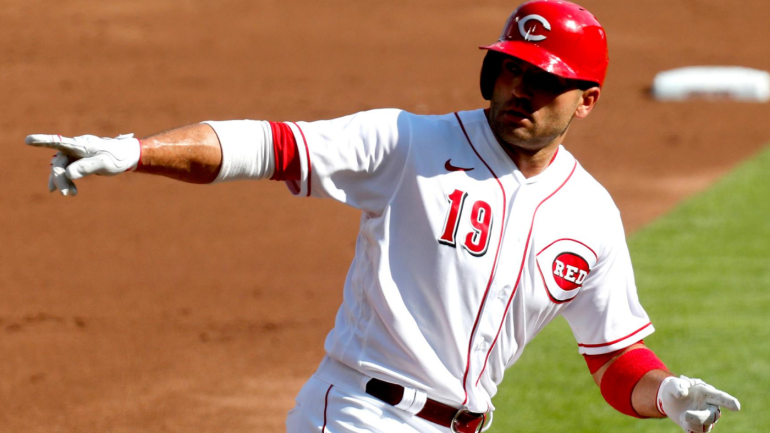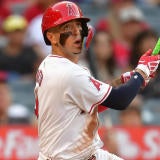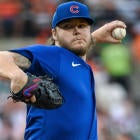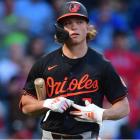
We're still too early into the Fantasy Baseball season to make many definitive declarations about any changes we've seen from players to date. I was reminded of this yet again Wednesday when I started looking at Vladimir Guerrero Jr.'s launch angle -- a key early-season storyline, given how important that seems to be to his chances of truly breaking out.
On the surface, the breakout is definitely happening for Guerrero, as he put together another two-hit effort Wednesday, pushing his line through 12 games to .390/.520/.585. Both of his hits had an exit velocity over 110 mph, extending his MLB lead on such batted balls to nine -- second place has six batted balls over 110 mph. He nine walks to nine strikeouts, too, and has a career-best .211 ISO. This is what we've been waiting for.
But, under the surface, there are still some signs that Guerrero is much the same guy he has been in recent years. While his average launch angle was up early on, after hitting three ground balls Wednesday it's down to 10.0 -- higher than his career 6.2 degree mark, which is great to see. However, while Guerrero had a 21.3 degree average launch angle in the first six games of the season, it's just 0.1 in six games since.
Which is to say, there's really no way we can say with any certainty whether Guerrero has truly changed what needed to be changed to fully unlock his potential. At this point, we're definitely still waiting on more information, and that's how it is with a lot of players. We're dealing with very small sample sizes because we're less than 10% of the way through the season.
It's hard to make any definitive cases right now, but what we can do is look at early trends and see what is worth paying attention to. So, here are 10 surprising early hitter stats to pay attention to moving forward:
1. League-wide average exit velocity is up .73 mph
This one isn't necessarily that surprising -- we had reason to believe average exit velocity would be up based on spring training data, as first reported by The Ringer. But we've seen that in action so far, though it's interesting to note that the biggest change to offense so far league-wide have been a bit surprising -- BABIP and HR/FB rate are both down from the previous two seasons despite that increased exit velocity, suggesting increased drag on the ball is having the expected impact (though environmental factors could play a part here, so we'll need a bigger sample size to judge here).
The biggest impact, then, is that the league-wide strikeout rate is already up to an all-time high of 24.7%. In that piece from the Ringer, they noted that strikeout rates were up in spring along with overall pitch movement, which could also be a result of increased drag on the ball's surface. You aren't imagining it: Offense really is down across the league, with batting average especially down to .234 -- lower than any season in major-league history. Maybe as the weather warms up we'll see a boost in offense, but right now, it's looking like 2021 might be another Year of the Pitcher.
2. League-wide stolen base success rate is up to 79.4%
That would be the highest rate in major-league history, shockingly, and it may not just be a result of some early-season small-sample size: In 2019, the SB success rate was 72.1%, and in 2018 it was 72.4%; the success rate for the full season was 73.2% and 72.1%, respectively. What's happening here? Well, one theory is that, as the stolen base has become rarer, the share of steal attempts by very good baserunners has gone up, though that still wouldn't explain the jump from 2019-2020 to 2021. Historically, there doesn't seem to be much of a relationship between stolen base success rate and the rate of times on base (minus triples and homers) that resulted in steal attempts. So, I don't think that's the answer.
Another theory that seems logical is that, as league-wide strikeout rates increase, pitchers are less worried about holding runners. The idea here would be that, because the chances of a ball in play happening are lower than ever, the risk of a runner moving up a base is lower, and defenses are more willing to essentially surrender the base. There's some reason to believe this to be the case -- while stolen base rates were all over the place early in baseball's history, with very little year-to-year consistency, strikeout rate and stolen base success rate have both steadily increased -- almost without regard for how often steal attempts are happening. Of course, that doesn't necessarily explain the jump from recent years to 2021, again. Fastball rate has held steady from 2020 after a consistent decline over the last decade, and average fastball velocity is up after hitting a plateau in 2020, so I'm not sure that explains it either.
My hypothesis -- and I'm not sure there's an actual way to test this, so it's just a hypothesis at this point -- is that the same factors impacting the overall offensive environment may be playing a part here. More movement on pitches could make it harder for catchers to catch the ball and get it out cleanly, while the increased drag could make it harder for catchers to throw accurately. Whatever the explanation is, it's something to keep an eye on, because it could lead to some better totals for the high-volume base stealers out there -- and maybe it might lead to more aggressiveness overall if the trend sticks.
3. Wilson Ramos -- First in hard-hit rate and average exit velocity
Just, y'know, don't tell Ramos. He looked pretty washed up in 2020 when he had just five homers and hit .239 -- his lowest average since 2015. However, Ramos has been an underrated hitter for a while now, with a .288 average or better in three of five seasons since, and he's always been something of a Statcast standout, with a hard-hit rate over 40% in all but one season since 2015. He's gone absolutely bonkers so far, and the most impressive thing might be that he's increased his launch angle from a career 3.9 degrees on average to 16.9 degrees. I have no idea if he can sustain that, but if he can, Ramos could certainly be one of the best hitting catchers in baseball.
4. Paul Goldschmidt -- Second in hard-hit rate
Goldschmidt hasn't seen the results yet -- he's hitting .256/.304/.372 entering play Wednesday -- but the process has been excellent so far. He's kept his strikeout rate gains from last season while seeing an increase in quality of contact, leading to his highest expected wOBA ever, per Statcast. I don't expect he'll keep that up, but I do think much better days are ahead for the veteran, who seems to be outrunning father time better than expected.
5. Akil Baddoo -- Seventh in expected wOBA
I've written about Baddoo several times already this season because I think he's an incredibly intriguing talent despite his lack of minor-league experience or pedigree. It's fair to be skeptical of whether his approach will catch up to him -- he has one of the lowest swing rates on pitches in the strike zone despite seeing a lot of pitches in the zone -- but he's already shown clear MLB-caliber skills, with a max exit-velocity in the 75th percentile among all hitters, a solid hard-hit rate of 44.4%, and an average sprint speed in the 93rd percentile. He's shown enough to be worth rostering in all five-outfielder leagues, and I think he's worth keeping on your bench in any category-based league.
6. Evan Longoria-- Sixth in average flyball/line drive exit velocity
Well, this one is certainly a surprise, and one I would likely chalk up to a hot streak in a small sample. Especially because Longoria has pretty consistently underperformed his expected stats four straight seasons now -- including when he posted a .308 wOBA despite a .362 xwOBA in 2020. However, what he's done so far isn't a fluke, at least, and it's not like he's been especially harmed by the shift in recent years, nor is he so slow of foot that you should expect him to consistently underperform his xStats the way someone like Miguel Cabrera has. Which is to say, maybe it's not out of the question Longoria can remain a viable Fantasy option.
7. Taylor Trammell -- Seventh in average flyball/line drive exit velocity
Trammell has real skills -- he's a patient hitter who has always gotten on base and he's shown there's some pop in this bat so far. The issue is, his strikeout rate has been so high he can't take advantage of those skills. He swings and misses an awful lot, and he's also let quite a few called strikes go against him thanks to a pretty low swing rate on pitches in the zone. If he can overcome those issues, he could be a very solid Fantasy option, but they're big impediments so far.
8. Joey Votto -- Ninth in average flyball/line drive exit velocity
Votto seemingly made a decision to trade some of his elite plate discipline for power in 2020, and we're seeing something similar so far -- his 48.6% swing rate is nearly 13 points higher than 2020, and he has his highest whiff rate ever, too. The results have been dreadful so far -- .178/.213/.311 -- but he's hitting the ball harder than ever, including a career-high max exit velocity already. Among all players with at least 25 balls in play this season, Votto is underperforming his expected wOBA by the most, and while he probably should underperform those expectations based on his new pull-heavy approach and his lack of footspeed making him easier than ever to shift against, he should still see much better results moving forward. He's a buy for me.
9. Gleyber Torres -- Sixth-lowest hard-hit rate
I think it makes sense to chalk this one up to an early-season slump, but it's at least worth acknowledging that it hasn't just been bad luck. He just isn't hitting the ball well right now -- he has a career-high chase rate, a career-high pop-up rate, and has hit just six batted balls higher than 95% -- a 22.2% rate compared to 36.0% and 38.0% the last two seasons. I expect he'll pull out of this, but Torres has some real issues with his swing and his approach that he needs to sort out before he breaks out of this.
10. Gavin Lux -- Fifth in average sprint speed
Lux has gotten the playing time we hoped for, but we haven't gotten the production we hoped for so far. His platoon issues have continued in the small sample size -- just one single in 11 PA vs. LHP -- but there are some reasons to be optimistic -- he's got a very solid 40% hard-hit rate and a 90.2 mph average exit velocity. Those are nice things to build on, but Fantasy players would especially like to see him take advantage of his speed more because it could be a real value-add for him. Lux has attempted just four steals in his 53 MLB games so far but had as many as 27 back in 2017, and at least 10 in both 2018 and 2019. There's still a lot to like about Lux, but he's more unfulfilled potential than anything else at this point.

















